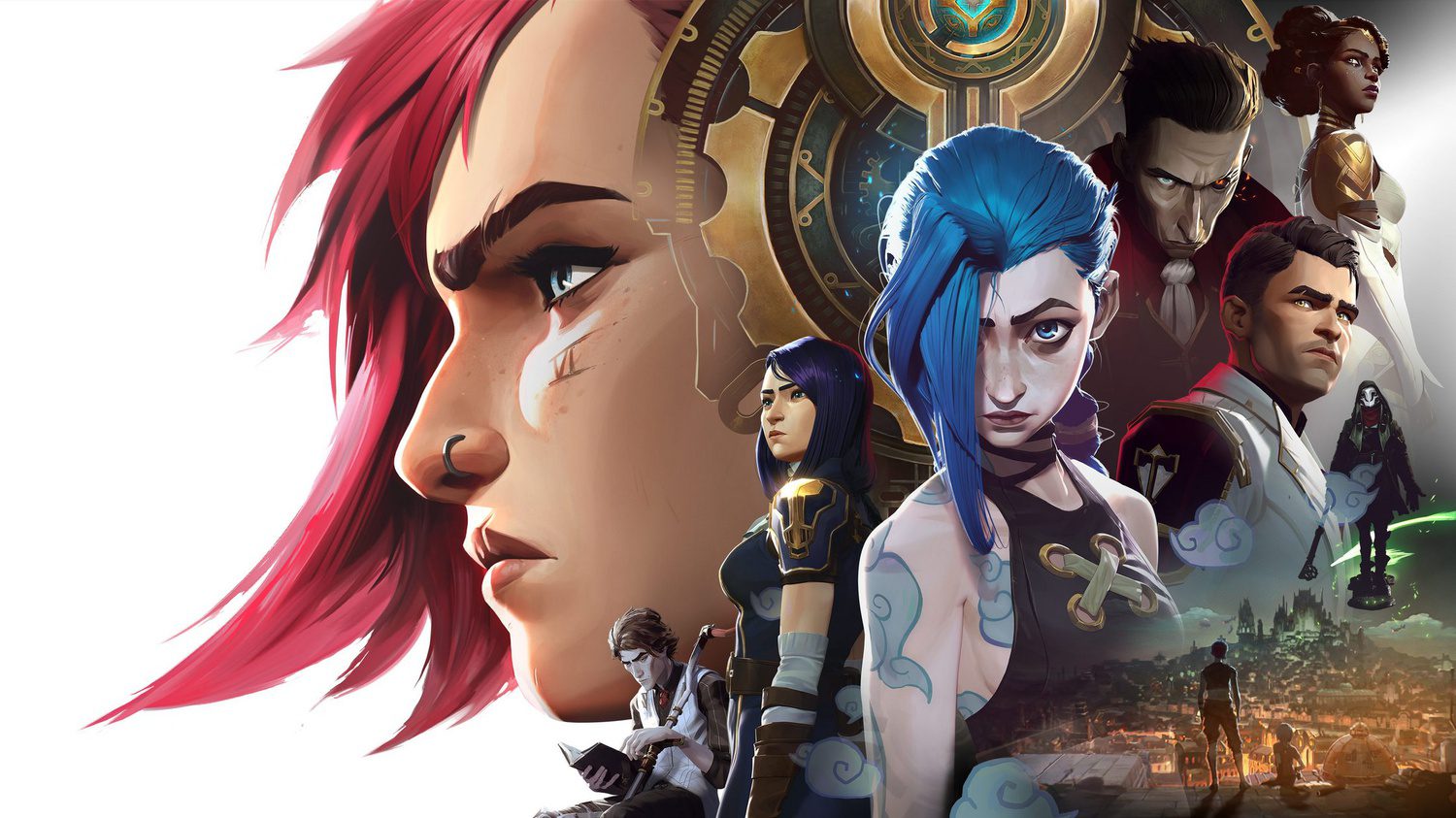Arcane boasts a massive world with complex characters you either love to root for or love to hate, a simple yet immersive and layered story, and absolutely gorgeous and groundbreaking animation with a unique visual style. Though it was already starting to crack, this League of Legends adaptation puts the final nail in the coffin of the “video game adaptation curse” by shattering preconceptions of what the animation medium is capable of, delivering a once-in-a-generation masterpiece that is sure to inspire both fans and storytellers alike for years to come. It does all of this all while delivering an exhilarating kick-ass story whether you know the entire history of Runeterra or you’re just looking for the next event series.
Based on the lore of League of Legends yet serving as a prequel to many character and story elements from the games, Arcane is set in the city of Piltover and its undercity district of Zaun. Arcane is mostly an upstairs, downstairs story, centering on the brewing tensions and social unrest in Zaun, where people live in harsh conditions and under the constant threat of Piltover’s brutal enforcers. From the start, Arcane does a fantastic job of introducing its expansive world full of rich history and lore without bombarding us with exposition by relying on visual storytelling and using easter eggs to hint at a larger world. The mechanical architecture of Zaun, the way a tavern changes its look from one arc to the other, and the statues referring to deities or past warriors all help tell that larger story without the need for many verbal explanations — much in the same way the original Star Wars did.
The actual plot focuses on two parallel storylines across the two locations. In Piltover, we follow Jayce and Viktor, two scientists on the verge of being able to harness magic through technology, and the societal cost of rapid technological advance. On the streets of Zaun, we follow orphan sisters Vi and Powder as they get involved with a heist gone wrong and the start of a gang war in Zaun with big consequences for both cities. Despite many moving parts and an abundance of plot points and worldbuilding, Arcane succeeds by staying grounded in its two intimate storylines. Sure, the show does explore important events with big ramifications for the world of Runeterra. Still, if you have never played the games (confession time, I have never even touched any of the Runeterra-set games), the character stories are what keep you engaged episode after episode; the lore is just icing on the cake to deepen everything within a larger story. This is a stark contrast to Netflix’s DOTA animated series, which focused so much on its lore and pleasing longtime fans it ended up a confusing mess for casual viewers.
Yet well-written characters are just part of it, as Arcane also boasts an impressive voice cast that helps bring a layer of emotion to the characters, from Katie Leung’s soft-spoken Caitlyn to Shohreh Aghdashloo’s regretful Grayson. Ella Purnell especially blends Jinx’s outbursts of rage with enough vulnerability to inspire both fear and pity whenever she’s on screen. At the same time, Hailee Steinfeld steals the show with her phenomenal portrayal of Vi’s entire arc throughout all nine episodes, bringing a worldful of pain and emotional baggage covered by a thick layer of toughness. Make no mistake, as cool as the fight scenes are, Arcane is more often than not heartbreaking, especially if you know the games and where certain characters end up. But even if you don’t, the show is full of surprises and plot twists that enhance the character journeys. There is a clear vision to make this the first stepping stone into a much larger world, one that seeks to join the likes of the MCU in terms of ambitious connective storytelling (albeit with a more visually inventive approach). Still, even as a self-contained season, Arcane ends on a satisfying yet equally heart-wrenching note.
One of the most successful elements of the show is the way it weaves in prequel tropes without drawing attention to them. We see many characters grow into fan-favorite champions from the games as they start getting their iconic looks and weapons, yet this is no Han Solo getting his last name from the fact that he had no family, or Jack Sparrow’s hat and braids getting origin stories. We get to see Vi picking up her gauntlets for the first time, but the show never stops to close in on them, and when she does pick them up, it’s at the climax of an emotional journey with a deep meaning to her character journey, rather than just an empty moment of fan service.
Like the games, Arcane does feature a ton of kick-ass action, and here is where the show goes from admirable to outright extraordinary, as it becomes the most stunning piece of animation since Into the Spider-Verse and one hell of an argument for animation as the best medium to adapt video games in. A lot of the praise deservedly goes to French animation studio Fortiche, which has worked on League of Legends cinematics for almost a decade since the Get Jinxed music video (there are enough needle drops in Arcane to reflect Riot Games’ history with stylish music videos). Their unique art style, which involves mixing 3D characters with 2D shading and flat colors, gives the show an airbrushed, painterly look that, combined with the world’s steampunk aesthetics, results in the closest we’ll likely get to a Dishonored series. Likewise, the show employs 2D for textures like water, smoke, and fire, which are animated using fewer frames than the characters. Combine that with the flat-painted backgrounds, and you get something resembling the old Disney multiplane cameras, a look that is neither too realistic nor too cartoonish. Where most 3DCG productions today look weightless and detached, the mix of 2D and 3D and the painterly art style helps give Arcane a sense of weight sorely missing from western animation, which comes to life in the kinetic action scenes that certainly pack heavy punches.
A few days ago, Adult Swim’s Jason DeMarco jokingly pointed out that Arcane had a budget more comparable with feature films than animated TV shows. The money is definitely evident in every frame of the show, especially the fight scenes. Just take a look at one scene from Marvel’s Rocket & Groot, which is also produced by Fortiche but doesn’t have the level of cinematic artistry that this show has. Arcane employs live-action techniques like lighting and contrast and complex camera movements to create kinetic action that looks realistic at the same time as it fully embraces the animation medium. One second, the camera will be moving fluidly and seamlessly, and the next, we’ll get a shaky-cam fight scene that reflects the chaos going on in our characters’ lives, while a healthy dose of slow-motion helps highlight the impact of the punches rather than just increase the running time.
This is not a show aimed at kids, and yet, Arcane is a rare Netflix animated show that doesn’t overdo it with the gore or profanity, resulting in something on the harder side of PG-13. Sure, there are a lot of violence and dark moments, and the characters don’t restrain from swearing, but it’s not done just for the sake of Netflix’s lack of censors. On the contrary, the show uses profanity and language to highlight the differences between those living in Piltover and those in Zaun, which adds to the worldbuilding.
Something else that’s unique about Arcane: it’s one of the few current animated shows with 40-minute episodes. Still, unlike something like Amazon Prime Video’s recent Invincible — which heavily compromised the quality of its animation in order to pack in as much story as possible into a season of TV — Arcane manages to sustain its quality throughout the first season’s nine episodes. This show feels more in tune with Maya and the Three, which Netflix heavily marketed as a theatrical-blockbuster level animated event, just extended to a season’s worth of story. You could easily picture Arcane being screened in theaters like it was a Lord of the Rings marathon, and like that trilogy, Arcane is very distinctly divided into three acts. Netflix released each arc in weekly batches, dividing the season into three separate yet connected 2-hour-long sections. Despite the length, the episodes have great pacing, packing a ton of story and worldbuilding while still finding the time to give the emotional moments enough room. Though, like the shimmer, it is hard to stop after just one taste, this is not a show meant to be consumed all in one go, lest you risk getting too engrossed in the story to breathe.
Verdict
Against all odds, Arcane delivers a killing blow to the idea that video games cannot be masterfully adapted into other mediums, with compelling characters, an endearing story, and fascinating lore and worldbuilding, as well as striking visuals that break new ground for what is possible in TV animation. Like Into the Spider-Verse, we’ll be talking about Arcane as a classic and a standard-setter for years to come.
![]()
![]()


